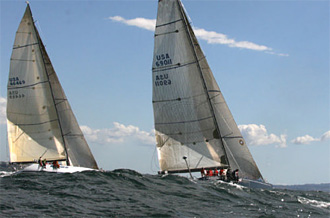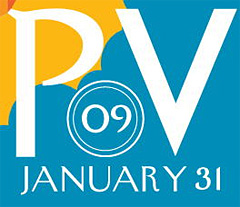
|  |  |  News from Around Banderas Bay | January 2009 News from Around Banderas Bay | January 2009  
PV09: Check 'Cross-Over Speed' Before Using Your Engine
 Sail World Sail World
go to original


| | Mag 80 passes Scout Spirit to leeward to take the lead - 2007 Marina Del Rey to Puerto Vallarta (Rich Roberts) |  |
For anyone planning to fire up their engines in offshore sailboat races like Del Rey Yacht Club's PV09 International Race Series to Puerto Vallarta, presented by CORUM Swiss Timepieces, there's a new rule in the 2009-2012 Racing Rules of Sailing they should know:

Part 4, 42.3 (h): Sailing instructions may, in stated circumstances, permit propulsion using an engine or any other method, provided the boat does not gain a significant advantage in the race.

Engine power has long been permitted in the so-called 'cruising' classes of some races, but 'significant advantage' is now fundamental, and PV09, starting Jan. 31, is bringing it into full play for the 20th biennial event, which expands on the popular Salsa Division model of recent years.

Because the new four-race format has three scheduled stopovers before reaching Puerto Vallarta, it's important to avoid having stragglers who fail to reach one destination before the next leg starts---Feb. 4 from Turtle Bay, Feb. 7 from Magdalena Bay and Feb. 10 from Cabo Falso.

It's also important that competitors who motor their way pay a price steeper than it would cost them to sail---thus, a new 'Cross-Over speed' formula that will be introduced in the race thanks to some clever DRYC members: David Feinstein, who suggested it; Allen Puckett, an aeronautical engineer who developed it (he once worked for Howard Hughes), and Peggy Redler, the race coordinator and former math teacher who implemented it into a computer code scoring system.

As Redler explained to a roomful of the sailing teams at a day-long pre-race workshop last weekend, 'The Cross-Over speed is based on a boat's PHRF rating and the speed of a virtual boat: 8 knots. The formula creates a unique speed for each boat that allows them to use their engine when their sailing speed drops below a certain point. It will not adversely affect their corrected time.'

But here's the joker: The Performance Handicap Racing Fleet system is based on time and distance.

'This is not a power boat race,' Redler emphasized, 'because the faster you go under power and the more distance you make gets you a higher penalty . . . and because we subtract how far you power, you get less sailing distance and therefore less [PHRF] handicap time allowed.

'But it's to your advantage when the wind is very light to turn the engine on, [or] if it's blustery, for the sake of controlling your boat.'

Once an engine is run and then turned off, the rules forbid re-starting it for another hour, preventing racers from picking their spots repeatedly in patchy conditions.

'This is more than just making your boat go faster,' Redler said. 'There are tactics and navigation involved. You need to know how to use GPS, charts, bearings. It's a multi-skill game. It's the only way you can have a multi-race event when you have to get the boats through one leg in time to start another.'

Details are in Section 13 of the Sailing Instructions.

Tom Redler, race committee chairman and husband of Peggy, said, 'This is the only race I know of that went to the trouble of working out a formula that would make it possible to use the engine and not degrade the race.'

One thing for sure: it all makes the navigators' lives more complicated---which is why two new awards will honor the spinnaker and non-spinnaker division navigators whose calculated finish times for the first three legs most closely match the times registered by the boats' on-board satellite transponder, which will operate on real time.

Except for the final finish off the beach at Puerto Vallarta, Peggy Redler noted, 'There are no lines on the water. They have to find them [with instrumentation].'

The four individual races are marked by stopovers along the Baja California peninsula: 376 nautical miles from Marina del Rey to Cedros Island outside of Turtle Bay; starting Feb. 4, 220 n.m. to Magdalena Bay, famous for its friendly migrating whales; starting Feb. 7, 152 n.m. to Cabo San Lucas at the tip of the Baja peninsula, and the last, starting Feb. 10, 286 n.m. across the Gulf of California to Puerto Vallarta on the mainland, finishing off the beach in Banderas Bay in front of the race headquarters Westin Resort & Spa.

The fleet has 16 boats, following the recent addition of two boats and the withdrawal of five, including Roy E. Disney's new Pyewacket V in what would have been its maiden race.

A disappointed Disney said, 'It's a real bummer, but the race falls into the recovery time of some non-life-threatening surgery.'

He said he would be back on the water for the Newport to Ensenada race, the Hoag Cup in June and his 16th Transpac to Hawaii in July.

The latest dropout was Charles A. Weghorn's Zamazaan from San Francisco. The Farr 52 lost its mast last week.

A skippers meeting and sendoff party are scheduled at Del Rey YC Jan. 30, the night before the start.

In Puerto Vallarta the fleet will be moored free at Opequimar Marina until Feb. 15. Complimentary membership in the Opequimar Yacht Club is included. The club is open 24/7, features several computers and Wi-Fi, a bar and restaurant, showers and other conveniences.

Confirmed entries

 Spinnaker-A Spinnaker-A

Amazing Grace (Farr 55), James Puckett, Del Rey YC
Carmagnole (Beneteau First 45), Dan Howard, DRYC
Dare (Beck 60), Bob Kettenhofen, Balboa YC
Felicita (J/120), Perry Peters, Arizona YC, Phoenix

Spinnaker-B

Barking Spider (Catalina 36 MK2), David Kory, Point Richmond, Calif.
Jungle Jim (Jeanneau 49), Jim Maslon, DRYC
Rose of Sharon (Burgess 59), Byron K. Chamberlain, Newport Harbor YC
Sleeper (Jeanneau 44), Ron Simonson, Cabrillo Beach YC
Tranquility (Beneteau First 40.7, Max Lynn, Santa Barbara YC

Non-Spinnaker-A

Blue Note (Beneteau 473), Kevin & Rhonda Wixom, Mission Bay YC
Defiance (Swan 56), Peter Noonan, St. Francis YC
Lumiere (Beneteau 49), Carl Marusak, MD, DRYC
Transformer (Beneteau 49), Joel Young, So. Bay Yacht Racing

Non-Spinnaker-B

Artsea (Grand Soliel 45), Marty Laffer, DRYC
G-Rated (Catalina 42 MK2), Sid and Mark Lampert, DRYC
Rhiannon (Peterson 44), Bill & Stacy Tarr, DRYC

More information at http://www.pv09.com/ |

 |
|  |



